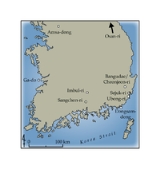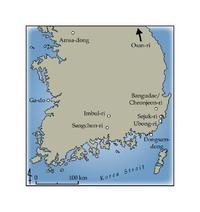
Dongsam-dong Shell Midden
Encyclopedia
Dongsam-dong Shell Midden or Shell Mound is located on the west coast of Yeong-do Island in Dongsam-dong, Yeongdo-gu
, Busan Metropolitan City, the Republic of Korea.
This archaeological site
consists of a midden
of shells of various mollusk taxa that were discarded in a relatively small or restricted area by people who lived there in the Jeulmun Pottery Period
. It was excavated three times by archaeologists of the National Museum of Korea
from 1969 and was found to be the among oldest Jeulmun middens so far discovered in the southern part of the Korean peninsula
. The presence of Yunggimun (appliqué-pattern) pottery indicates the site was occupied for a time between 8000-7000 BC, but many absolute dates generated from carbon that was excavated from the site indicate the site was also occupied in the Middle (c. 3500 BC) and Late (c. 2000 BC) Jeulmun sub-periods.
 A variety of artifacts, including three types of pottery (patternless, comb-patterned, and appliqué patterned), and tools made of bone and stone
A variety of artifacts, including three types of pottery (patternless, comb-patterned, and appliqué patterned), and tools made of bone and stone
were uncovered. Artifacts and features from Dongsam-dong provide insight into the way the people of the area lived as well as into the cultural trends of the times.
The excavated remains have also proved to be valuable for estimating both the influences of Siberian culture on Korea and prehistoric exchange between southern Korea and Kyūshū
, Japan
.
Yeongdo-gu
Yeongdo-gu is a gu in Busan, South Korea. The gu itself is limited to Yeong-do located on the south edge of central Busan...
, Busan Metropolitan City, the Republic of Korea.
This archaeological site
Archaeological site
An archaeological site is a place in which evidence of past activity is preserved , and which has been, or may be, investigated using the discipline of archaeology and represents a part of the archaeological record.Beyond this, the definition and geographical extent of a 'site' can vary widely,...
consists of a midden
Midden
A midden, is an old dump for domestic waste which may consist of animal bone, human excrement, botanical material, vermin, shells, sherds, lithics , and other artifacts and ecofacts associated with past human occupation...
of shells of various mollusk taxa that were discarded in a relatively small or restricted area by people who lived there in the Jeulmun Pottery Period
Jeulmun pottery period
The Jeulmun Pottery Period is an archaeological era in Korean prehistory that dates to approximately 8000-1500 BC.. It is named after the decorated pottery vessels that form a large part of the pottery assemblage consistently over the above period, especially 4000-2000 BC. Jeulmun means...
. It was excavated three times by archaeologists of the National Museum of Korea
National Museum of Korea
The National Museum of Korea is the flagship museum of Korean history and art in South Korea and is the cultural organization that represents Korea...
from 1969 and was found to be the among oldest Jeulmun middens so far discovered in the southern part of the Korean peninsula
Korean Peninsula
The Korean Peninsula is a peninsula in East Asia. It extends southwards for about 684 miles from continental Asia into the Pacific Ocean and is surrounded by the Sea of Japan to the south, and the Yellow Sea to the west, the Korea Strait connecting the first two bodies of water.Until the end of...
. The presence of Yunggimun (appliqué-pattern) pottery indicates the site was occupied for a time between 8000-7000 BC, but many absolute dates generated from carbon that was excavated from the site indicate the site was also occupied in the Middle (c. 3500 BC) and Late (c. 2000 BC) Jeulmun sub-periods.

Stone tool
A stone tool is, in the most general sense, any tool made either partially or entirely out of stone. Although stone tool-dependent societies and cultures still exist today, most stone tools are associated with prehistoric, particularly Stone Age cultures that have become extinct...
were uncovered. Artifacts and features from Dongsam-dong provide insight into the way the people of the area lived as well as into the cultural trends of the times.
The excavated remains have also proved to be valuable for estimating both the influences of Siberian culture on Korea and prehistoric exchange between southern Korea and Kyūshū
Kyushu
is the third largest island of Japan and most southwesterly of its four main islands. Its alternate ancient names include , , and . The historical regional name is referred to Kyushu and its surrounding islands....
, Japan
Japan
Japan is an island nation in East Asia. Located in the Pacific Ocean, it lies to the east of the Sea of Japan, China, North Korea, South Korea and Russia, stretching from the Sea of Okhotsk in the north to the East China Sea and Taiwan in the south...
.

